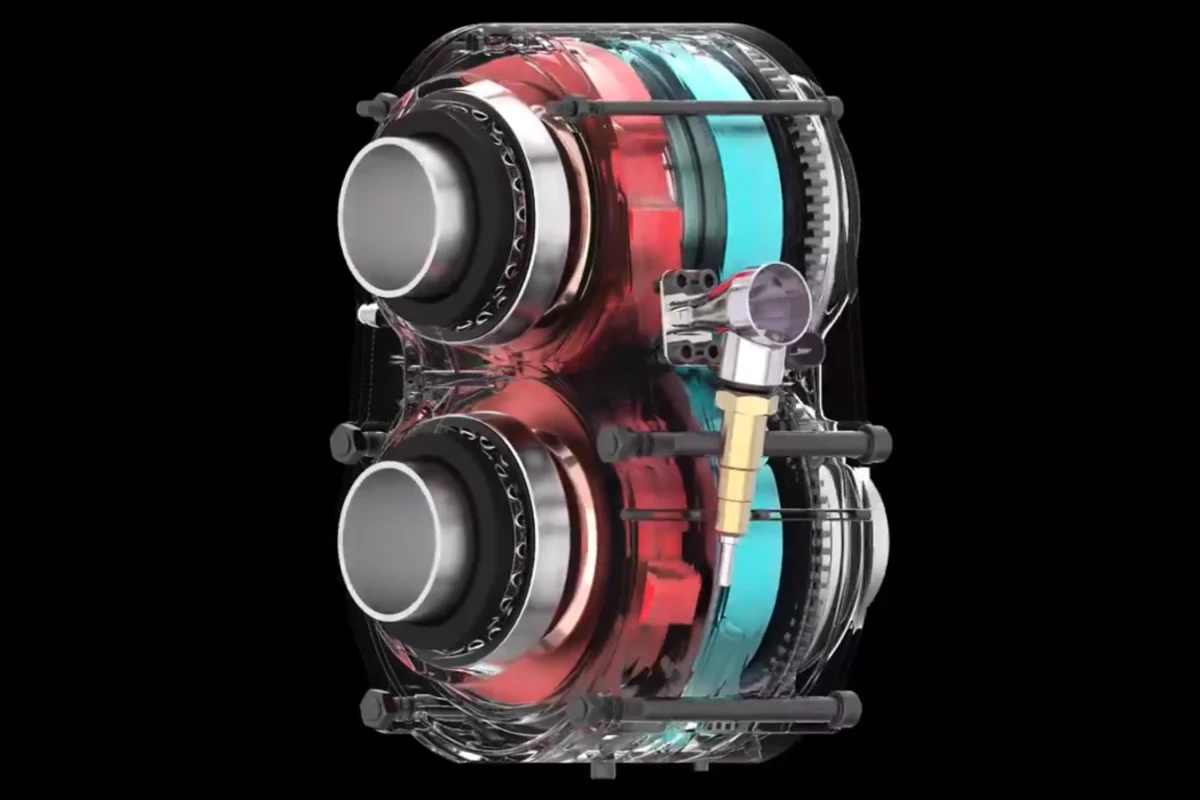Astron aerospace has shown a partial prototype of a new rotary combustion engine it claims runs at an extraordinary 60% thermal efficiency, burning totally clean with zero NOx emissions and nothing but fresh water out of the tailpipe.
With internal combustion engines (ICE) on the way out and electric vehicles (EV) on the way in – both politically and environmentally – innovative ways of using renewable energy for clean transportation are at the forefront of many engineering minds.
Astron Aerospace has recently announced its latest novel innovative engine, the H2Starfire. It's a sort of Wankel-rotary design, but with an interesting twist: there are no planetary gears or apex seals. Instead, there are two counter-rotating shafts that have incredibly tight, frictionless tolerances, using ceramic coatings and titanium to prevent the escape of pressurized gas and mitigate heat deformation. We're talking 0.002-0.004 of an inch (less than 0.1 mm) tolerances.
The "H2," of course, stands for hydrogen – a gas that's notoriously difficult to store and transport. The most common method of producing hydrogen as it stands is steam methane reforming – cheap, but not green. You can also make it by splitting water in an electrolyzer using renewable energy, which makes it green, but not cheap. You then need to squash it to 700 times atmospheric pressure, or cool it close to absolute zero to store it – and even then, it'll boil off, and its tiny molecules will gradually sneak out straight through the walls of metal containers.
Compared to batteries, it's an inefficient and ornery way to store energy. But when burned at temperatures under 1,400 °F (760 °C) in the right conditions, it'll happily run a combustion engine that provides all the noise, vibrations and mechanical drama that petrolheads are scared to lose – and the only byproducts emitted are clean, pure water and a few unfortunate nitrous oxides (NOx) at higher temperatures. Many companies appear to view hydrogen combustion as the clean future of 'enthusiast'-grade vehicles.

And that's the plan for the Astron H2Starfire. Using two sets of counter-rotating rotors with an aluminum front half for the engine's intake and compression and a titanium rear half for expansion and exhaust, Astron claims it's been able to eliminate the need for water cooling entirely, reducing weight and complexity, and achieving greater than 60% thermal efficiency.
For comparison, a typical car engine runs at closer to 20% thermal efficiency according to Green Car Reports, meaning 80% of the energy released in combustion is lost as waste heat. The best street car engines get closer to 40%, and you might get 50% from a Formula One engine built out of yeti teeth and unicorn dandruff. Sixty percent is an extraordinary claim.
Extraordinary claims demand extraordinary proof, and while Astron appears to have built and run a partial prototype, we don't feel this proof currently qualifies as extraordinary:
But Astron is so confident in its design efficiency – and its ability to run cool – that it claims the engine produces zero NOx emissions. These are unavoidable when fuel is burned in air over about 1,300 °C (2,370 °F), and some of the nitrogen in the air starts to burn.
Air is drawn in via carburation or fuel injection through the front half of the engine, where it is squeezed down and compressed to 200-300 psi (13.8-20.6 bar) – very much like a compressor – and injected with hydrogen fuel before escaping through a fixed vent port into the center of the engine that connects both halves. Once the air and fuel combination have passed to the rear, a spark or glow plug ignites the mixture, causing explosive compression to spin the lower output shaft, before exhausting clean water vapor out of the opposite side of the engine.
All of this happens on a 270° rotation that idles at 1,000 rpm, and revs up to a screaming 25,000 rpm, perfectly timed with a set of connected gears on each of the upper and lower shafts. It's difficult to imagine, but Astron provides a video to show the process:
If you know anything about traditional rotary engines, oil consumption is an issue. Since the H2Starfire is a completely linear rotating engine design, there's no need for apex seals. As we mentioned earlier, Astron claims the engine is nearly frictionless, and tolerances are so tight that only the the timing gears and bearings need oiling. In fact, the entire design of the engine is only 82 individual parts.
According to one source (which I'm thus far unable to verify as a real person), the H2Starfire is compact. Really compact. And it makes gobs of horsepower and torque. At 11.4 x 12.5 x 17.3 inches (29 x 32 x 44 cm) and weighing a fairly hefty 120 lb (54 kg), it produces 400 hp (298 kW) and 500 lb-ft (678 nm) of torque.

We've reached out to Astron Aerospace for more information, but after several days we've received nothing in response.
We'd love to hear from the company (and hopefully see something better than a video of someone turning the motor over with a power drill to qualify as a working demonstration) ... We'll run an update if and when we learn more.
It's no small effort bringing a new combustion engine to market, let alone a new type of rotary ... Let alone bringing a hydrogen-powered rotary into a market where hydrogen fuel is still incredibly scarce.
But a super-efficient, clean-burning combustion engine with zero NOx emissions ... For those of us who will always love the scream of a highly-tuned combustion motor and the mechanical joy of a gearbox and clutch, innovations like this give some hope that the fully immersive driving experience we've enjoyed for more than a century might yet have a future.
Source: Astron Aerospace






